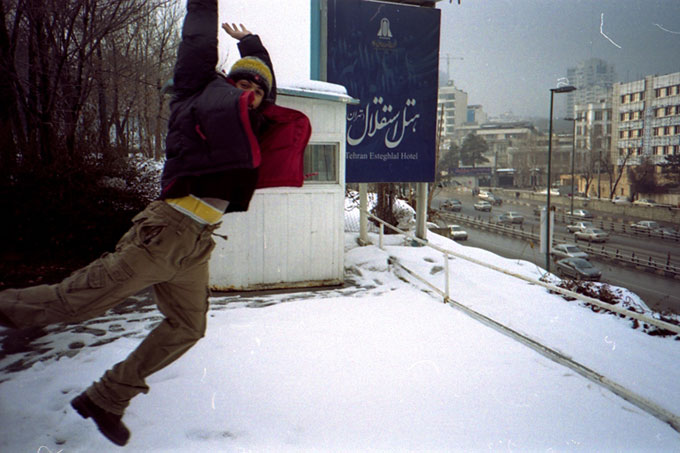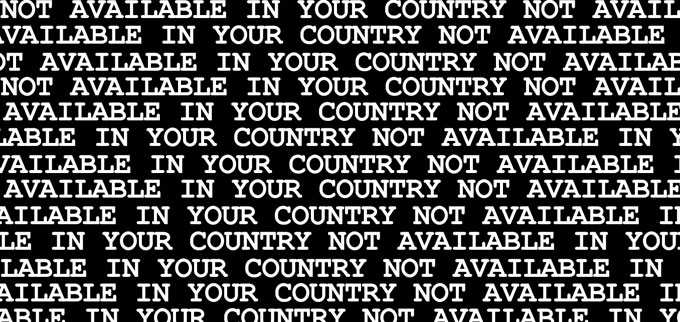
Mohsen in Tehran. Photo courtesy of the author.
My best friend, Mohsen, and I were very close in our early twenties. We used to stay up all night playing video games and listening to music. We also worked and traveled together, organizing group exhibitions and touring them around Iran. In 2008 we were busy preparing to open an art space and studio together.
Mohsen was working as a photographer for an Iranian movie being made in Iran and Kyrgyzstan, so he traveled to Bishkek, the capital of Kyrgyzstan. He insisted that I come with him, but I couldn’t, as I was on vacation with my family in the north of Iran at the time. So we kept in touch by email while he explored Bishkek, meeting new people and indulging two of his passions: finding old photography equipment and chancing on interesting graffiti. We spoke on the phone before his flight back to Tehran, and he suggested that we travel there together soon. A few hours later his plane crashed.
Flight 6895 was a charter flight to Tehran, operated on behalf of an Iranian airline, which crashed on August 24, 2008, near Manas International Airport in Kyrgyzstan. It crashed while returning to Manas after experiencing technical difficulties. There were some 80 people on board. More than 60 of them died, including Mohsen. He was only 24 years old.
The sanctions do not just determine what we can buy or with whom we can trade; they have changed the very air we breathe.
In the last 25 years Iranian planes have been involved in 13 crashes and many other accidents, resulting in 700 deaths and many more debilitating injuries. With this abysmal safety record, the odds that an Iranian air passenger will die on a flight are much higher than those for passengers on the world’s major carriers.
Iranians have little choice but to take these flights—and these risks—because Western sanctions prohibit Iran and Iranian airlines from purchasing Boeing or Airbus planes on the open market, even secondhand. The country’s aging civilian fleet includes planes that first entered service before the Iranian Revolution in 1979, when the United States first began to impose sanctions on Iran. In the subsequent years, airlines have struggled to source parts and technical support for their aircraft.
The U.S. government has imposed sanctions on Iran with every administration since 1979 but expanded its sanctions dramatically in 2005. United Nations sanctions quickly followed in 2006, when the U.N. Security Council passed Resolution 1737 and imposed its first major round of sanctions. In 2006 not many Iranians were worried about what the sanctions meant for the coming years. But by 2010 much of the international community—including European governments previously critical of U.S. sanctions—held policies similar to those of the United States. And in October 2012 the Iranian rial fell to a record low against the U.S. dollar, having lost 80 percent of its value within a single year.
It was unpleasant, if unsurprising, to be asked to prove that I wasn’t an arms trader.
The effects of the sanctions and the crash were felt all around the country, in many different ways, and they continue to shape the lives and livelihoods of Iranians. The sanctions do not just determine what we can buy or with whom we can trade; they have changed the very air we breathe. Several of the world’s most polluted cities are in Iran, in part because sanctions led the government, flush with petroleum but reliant on foreign oil refineries, to convert factories into makeshift oil refineries that mix gasoline with benzene, a lethal carcinogen. Today poor-quality fuel chokes the air of cities like Ahvaz and Tehran with pollutants, contributing to ill health and tens of thousands of deaths.
As a freelance curator and director of Sazmanab, a nonprofit art center in Tehran, I felt the effects of the sanctions in the air but also in my work. I organize exhibitions both inside and outside Iran, and for me the crash meant a sudden halt to participating in the art fairs where we could meet artists, curators and collectors around the world. We simply could not afford to rent booths. Because I could not afford frequent travel, I could accept only those curatorial offers from outside Iran that funded shipping and production costs associated with the exhibition. I began to curate more exhibitions with videos so that I could upload the art without needing to be physically present at the host venues.
The economic situation at that time affected more than the circulation and sale of art; it also meant that artists could no longer afford the materials necessary to make art in the first place. In the fall of 2012 I saw instances when the price of a camera doubled within a week. The tools necessary to paint, sculpt or make installations were suddenly far out of reach for most artists. This gave rise to a market for cheaply produced goods; new, lower-quality merchandise started to pour in, mostly from China. Some artists made the best of these cheaper products while others decided to experiment in less expensive mediums, for example, creating videos if they already owned a decent digital camera.
The sanctions touch everything, but nothing is comparable to the effects that sanctions have had on the health and safety of Iranians.
A climate of isolation and austerity has made it very difficult for me to organize international shows and to promote conversations between Iran’s artistic community and the rest of the art world. For Iranian curators working on international exhibitions, it’s not uncommon to be constantly asked for proof that the funds are in fact being used to pay the artists and not to buy arms. It was unpleasant, if unsurprising, to be asked to prove that I wasn’t an arms trader. For an Iranian, getting paid is always tricky. With Western bank branches and PayPal unavailable in Iran, it is difficult to transfer money into the country. It helps to have family and friends living abroad, but even then transfers may be delayed and deferred, or those making the transfers may even have their accounts frozen.
As my family, friends and I have been increasingly impacted by sanctions, I have decided to make reflecting on the sanctions part of my work. I have participated in conversations about the negative effects of sanctions on Iranian artists, and since 2013 I have been collecting firsthand accounts from those directly affected. They reveal an artistic community producing vibrant work despite feeling cut off from the rest of the world.
There are countless other examples of the effects of sanctions on our daily lives. The sanctions touch everything, from art and academia to food and clothing. But nothing is comparable to the effects that sanctions have had on the health and safety of Iranians. Patients and their relatives line up at pharmacies in Tehran. Those suffering from cancer, hemophilia, kidney problems and other diseases are increasingly told that the foreign-made medications they need are no longer available. It is estimated that about 6 million patients, many of them with cancer, are affected by shortages of medical equipment and medications.
When Hassan Rouhani was elected president of Iran in June 2013, many Iranians hoped he would bring an end to the U.S. sanctions against Iran and play the role of peacemaker with the West, though some were skeptical. When talks began between Iran and six world powers, including the United States, it seemed like a good sign. Still, some Iranians considered leaving the country or closing their businesses if an agreement was not reached. On April 2, 2015, the P5+1 and Iran reached a provisional agreement: Iran would allow inspections of its nuclear facilities, and other nations would lift their sanctions. Some opponents of Rouhani have criticized the agreement, but after the announcement was made, many Iranians took to the streets to celebrate.
The final agreement, if reached in the days to come, would mean that sanctions will be lifted. Though it would take months for changes to be felt, most people I meet with these days believe that there is still a good chance for a final agreement. The atmosphere in Tehran is optimistic. I feel hopeful and eagerly anticipate the day when the sanctions are lifted for good.
In the meantime Iranian artists will continue to do what we have always done: create art in a community that dreams big and loves its craft, no matter what tools we have at hand.

Sohrab Kashani. Not Available in Your Country. 2015.

